Dublin Airport
| Dublin Airport Aerfort Bhaile Átha Cliath | |||||||||||||||
|---|---|---|---|---|---|---|---|---|---|---|---|---|---|---|---|
|
| |||||||||||||||
 | |||||||||||||||
| IATA: DUB – ICAO: EIDW | |||||||||||||||
| Summary | |||||||||||||||
| Airport type | Public | ||||||||||||||
| Owner | Government of Ireland | ||||||||||||||
| Operator | DAA | ||||||||||||||
| Serves | Dublin, Ireland | ||||||||||||||
| Location | Collinstown,[1] Fingal, Ireland | ||||||||||||||
| Opened | 19 January 1940[1] | ||||||||||||||
| Hub for | |||||||||||||||
| Elevation AMSL | 242 ft / 74 m | ||||||||||||||
| Coordinates | 53°25′17″N 006°16′12″W / 53.42139°N 6.27000°WCoordinates: 53°25′17″N 006°16′12″W / 53.42139°N 6.27000°W | ||||||||||||||
| Website |
www | ||||||||||||||
| Map | |||||||||||||||
 DUB Location within Ireland | |||||||||||||||
| Runways | |||||||||||||||
| |||||||||||||||
| Statistics (2015) | |||||||||||||||
| |||||||||||||||
Dublin Airport, (Irish: Aerfort Bhaile Átha Cliath) (IATA: DUB, ICAO: EIDW), is an international airport serving Dublin, the capital city of Ireland. It is operated by Dublin Airport Authority (DAA).[5] The airport is located 5.4 nmi (10.0 km; 6.2 mi) north[2] of Dublin in Collinstown, County Fingal. In 2015, over 25 million passengers passed through the airport, making it the airport's busiest year on record.[6] It is also the busiest of the state's airports by total passenger traffic. It also has the greatest traffic levels on the island of Ireland, followed by Belfast International Airport, County Antrim.
The airport has an extensive short and medium haul network, served by an array of carriers, as well as some intercontinental routes focused in the Middle East and North America. It serves as the headquarters of Ireland's flag carrier – Aer Lingus, regional airline Stobart Air, Europe's largest low-cost carrier – Ryanair, and ASL Airlines Ireland, together with another two airlines, CityJet and Norwegian Air International,[7] which don't maintain major operations there.
United States border preclearance services are available at the airport for U.S.-bound passengers. Shannon Airport is the only other airport in Europe to offer this facility.
History
The beginnings in the 1930s and 1940s
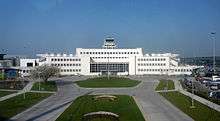
In 1936 the Executive Council of the Irish Free State established a new civil airline, Aer Lingus, which began operating from the military aerodrome, Casement Aerodrome, at Baldonnel to the southwest of Dublin. A decision was made that a civil airport should replace Baldonnel as Dublin's airport. The townlands of Collinstown, Rock and Corballis in the Barony of Coolock were selected as the location for the new civil aerodrome. Collinstown's first association with aviation was as a British military air base during World War I. The site at Collinstown had originally been selected as a base for the British Royal Flying Corps in 1917 and by April 1918, when the Flying Corps was renamed the Royal Air Force, the base at Collinstown was more than 20% complete. Construction of the military airport was completed in 1919, and at the end of 1922 the land and buildings at Collinstown were transferred to the Irish Free State. The airfield quickly fell into disrepair and grass grew on the former runways.
Work on the new airport began in 1937. By the end of 1939, a grass airfield surface, internal roads, car parks and electrical power and lighting were set up. The inaugural flight from Dublin took place on 19 January 1940 to Liverpool. In August 1938, work began on a new airport terminal building. The terminal building was designed by architect Desmond FitzGerald, brother of politician Garret FitzGerald.[8] FitzGerald, who had designed an airport terminal as part of his college studies, led a team of architects that also included Kevin Barry, Daithí Hanley, Charles Aliaga Kelly, Dermot O'Toole and Harry Robson. The terminal building opened in early 1941, with its design heavily influenced by the tiered structure of the luxury ocean liners of the time. The terminal was awarded the Triennial Gold Medal of the Royal Hibernian Institute of Architects in 1942 and is today a listed building.
.jpg)
Due to World War II, which was know as The Emergency in the Irish Free State, services were severely restricted at Dublin Airport until late 1945. The only international scheduled route operated during this time was by Aer Lingus to Liverpool (and for a period to Manchester's Barton Aerodrome). The end of the war meant the beginning of a major expansion in services at the airport. Aer Lingus resumed its London service to Croydon in November 1945. In 1947, KLM started the first European flights to Dublin with a service to Amsterdam. Three new concrete runways were completed in 1948, and in 1950 - after ten years in operation - the airport had welcomed a total of 920,000 passengers. [9]
Expanding in the 1950s, 1960s and 1970s
Throughout the 1950s Dublin Airport expanded with virtually uninterrupted traffic growth. Runway extensions and terminal enhancements were carried out to deal with the influx of traffic and passengers. New airlines began serving the airport also. These included British European Airways, Sabena, and BKS.
In 1958, a new transatlantic service was started by Aer Lingus via Shannon Airport. By the mid 1950s, it was clear that the original terminal building was too small to cope with growing passenger numbers. A new North Terminal was opened in June 1959. Originally, the plan was that North Terminal would handle all US and European flights, but instead it became the arrivals terminal for all Dublin Airport passengers, while the original passenger terminal was used for departures.[10]
During the 1960s, the number of scheduled carriers continued to grow and aircraft continued to evolve with technological advancement. By the close of the 1960s, a sizeable number of Boeing 737s, BAC One-Elevens, Boeing 707s and Hawker Siddeley Tridents were using the airport on a regular basis. To cope with larger aircraft in the late 1960s new departure gate piers were added close to the old terminal to cope with larger aircraft.[11] These piers would subsequently be connected to Terminal 1. During 1969, the airport handled 1,737,151 passengers.
The advent of wide-body aircraft posed opportunities and challenges for aviation. In 1971, Aer Lingus took delivery of two new Boeing 747 aircraft; the first one arrived in March and, shortly afterwards, performed a flyover above O'Connell Street in Dublin on Saint Patrick's Day; a third Boeing 747 was delivered later that decade. To cope with this, a new £10 million passenger terminal capable of handling six million passengers per year, which became known as Terminal 1, was opened in June 1972.[12] The growth which was anticipated at Dublin's airport (and provided for through heavy investment by the airport and Aer Lingus) during the 1970s did not materialise immediately.
%2C_Dublin%2C_July_1993.jpg)
%2C_Dublin%2C_July_1992_(01).jpg)
%2C_Dublin%2C_May_1994.jpg)
%2C_Dublin%2C_May_1994.jpg)
Continuing in the 1980s and 1990s
In 1983 Aer Lingus opened its 'Aer Lingus Commuter' division which took delivery of Shorts, Saab AB and Fokker turboprop aircraft to open regular daily domestic services to and from Ireland's smaller regional airports for the first time, as well as to serve existing routes to smaller regional airports in the United Kingdom. At various stages of its operations, flights were operated to several Irish regional airports to feed passengers into Aer Lingus's international network. These domestic destinations included Cork Airport, Shannon Airport, Kerry Airport, Galway Airport, Ireland West Airport Knock, Waterford Airport, Sligo Airport and City of Derry Airport. Aer Lingus Commuter has since been re-absorbed into the main company. The domestic routes, with the exception of Dublin-Shannon, were taken over by Aer Arann. Most of these routes have since been discontinued as the development of the motorway network in Ireland has resulted in significant reductions in travelling time by road. Aer Lingus has continued with the remaining Dublin–UK flights.
During the 1980s, major competition, especially on the Dublin–London routes, resulted in passenger numbers swelling to 5.1 million in 1989. In the same year a new 8,650 ft (2,640 m) runway and a state-of-the-art air traffic control centre were opened. Dublin Airport continued to expand rapidly in the 1990s. Pier A, which had been the first extension to the old terminal building, was significantly extended. A new Pier C, complete with air bridges, was built and as soon as this was completed, work commenced to extend it to double its capacity. The ground floor of the original terminal building was returned to passenger service after many years to provide additional departure gates. Pier D, completed in October 2007, is a dedicated low-fares boarding area and provides 14 quick turn-around stands and departure gates; these are not served by air bridges.
The Bilateral Air Transport Agreement
In 1993, a major milestone for the airport was the signing of a new United States – Ireland bilateral agreement which allowed airlines to operate some direct transatlantic services for the first time to/from Dublin Airport instead of touching down en route at Shannon Airport on the west coast of Ireland. (Shannon had once been a major transatlantic refuelling stop for pre-jet aircraft, and this agreement was designed to protect the interests of the Shannon region when modern jets no longer required a refuelling stop and Shannon saw a fall-off in traffic.) Airlines still had to provide an equal number of flights either to or through Shannon as to Dublin. A gradual further watering down of Shannon's so-called 'stopover' status came into effect in November 2006 when more direct flights to Dublin were allowed. The stopover requirement disappeared completely in 2008. At that time, airlines were allowed to fly direct to the US from Dublin without having to match these with any to/from Shannon. It was expected that this would result in a huge increase in services between Dublin and the US and Aer Lingus has identified 16 destinations that it would like to serve directly from Dublin.
Recent history
With the success of Ireland's 'Celtic Tiger' economy, Dublin Airport saw growth in the 1990s and 2000s. This demand was driven by an increased demand for business travel to and from the country, together with an increase in inward tourism and a surge in demand for foreign holidays and city breaks from the Irish.
Finally, the demand from Ireland's migrant workers, principally those from Eastern Europe, has resulted in a large number of new routes opening to destinations in the European Union accession states. Ireland was one of only three European Union countries (as well as the United Kingdom and Sweden) to open its borders freely to workers from the ten accession states that joined the European Union in 2004. This resulted in hundreds of thousands of people moving to Ireland from these countries since then.
The airport saw significant declines in traffic in 2009 and 2010, although since 2011 the airport has seen an increase in traffic. During 2012, this increase continued with passenger numbers growing by 1.9%. During 2013, passenger numbers at Dublin Airport were above the 20 million mark for the first time since 2009 with a 5.6% increase year on year. During 2014, this positive trend continued with an 8% increase over 2013. As of early December 2015, passenger figures have increased by 16% compared to 2014, and the previous record of 23.46 million passengers set in 2008 has already been passed.[13]
Long-haul traffic
DAA has ambitious long-haul expansion plans and has successfully added new routes to North America and the Middle East in recent years. It has yet to secure a direct route to East Asia.
Dublin Airport operates Intercontinental routes to North America, Africa and the Middle East. In total, 22 Intercontinental destinations are connected directly to Dublin Airport.[14] In 2007, Etihad Airways opened a flight between Dublin Airport and Abu Dhabi with 10 flights weekly in operation since March 2010. In addition, Emirates have operated a direct connection to Dubai since January 2012. In total, there are 17 destinations in North America connected directly to Dublin Airport by Aer Lingus, Air Canada Rouge, American Airlines, Delta, United Airlines and Ethiopian Airlines. WestJet and AirTransat also operate seasonal routes to the Canadian cities of Montréal, Toronto and St. John's.[14] In 2015 Ethiopian Airlines open the first direct link between Dublin and Africa,[1] excluding holiday services to Morocco, Tunisia and Egypt.
Open Skies and the Shannon Stopover
In the mid twentieth century, the Irish government introduced a rule stating that all air traffic between Ireland and the United States must transit through Shannon airport. In return, the United States government placed a limit of four airports in the US that Aer Lingus could operate to. On 22 March 2007, the Open skies agreement between the US and EU was ratified. This resulted in the immediate cancellation of the long-running 'Shannon Stopover' requirement, whereby the Irish government had insisted that 50% of all transatlantic flights between Ireland and the United States must pass through Shannon Airport.[15]
US border preclearance
Dublin Airport is one of only two airports in Europe with United States border preclearance services for US-bound passengers (the other being Shannon Airport). It allows passengers to have their paperwork dealt with before departure saving time upon arrival in the United States.[16]
Aer Rianta and DAA/Dublin Airport Authority
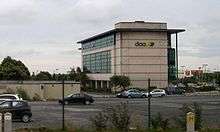
In October 2004, Aer Rianta (which means 'Air Ways' or 'Air Tracks' in Irish) was renamed as the Dublin Airport Authority plc, following the State Airports Act 2004. All assets and liabilities previously owned by Aer Rianta were transferred to Dublin Airport Authority. The State Airports Act 2004 also established new airport authorities at Shannon and Cork Airports. The Shannon Airport Authority and the Cork Airport Authority had separate boards of directors and were authorised under the Act to prepare business plans, which may have in time lead to their full separation from the Dublin Airport Authority. Following a decision by the Irish Government, Shannon Airport became a separate publicly owned airport on 31 December 2012.
In July 2013, the Dublin Airport Authority was officially renamed "DAA plc" by the Irish Government. The rename was principally to remove the "Dublin" and "Authority" elements of the name which were seen to have little relevance to the overall functions of DAA.[17] The name change announced in July 2013 took effect on 6 November 2014.[18]
As the largest gateway to Ireland, over 25 million passengers travelled through the airport in 2015, a 15% increase over the previous year.[19] The main contributors to the growth in traffic in 2015 were the 23 new routes launched during the year and extra capacity on 40 existing services. Both long-haul and short-haul traffic increased by 15% in 2015. A record 8.9 million people travelled between Dublin Airport and Britain during 2015, which was a 14% increase on the previous year.[19] Dublin Airport also welcomes more than one million passengers per annum from Northern Ireland and is a key international gateway for overseas visitors to Northern Ireland.,[20] whose largest airport is less than a quarter the size of Dublin in terms of passenger numbers.
Passenger terminals
Terminal 1
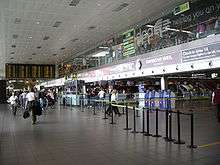
The current Terminal 1 building opened in 1972 was designed to handle five million passengers per year. The original design included a second pier which would have been identical to the current decagon-shaped boarding Pier B, but this was never built. A car park was originally located on the upper floor of the building and the access ramps are still in place but it was closed for security reasons in the 1970s and converted into offices. Terminal 1 has been regularly extended and improved over the last two decades. In October 2007, a new pier designed by Larry Oltmanns, while design director of the London office of Skidmore, Owings & Merrill,[21] who also designed graphics for its interior, was opened to the north of terminal 1.[22] This pier caters for the majority of Ryanair flights. In 2009, a new extension featuring new food and retail outlets was added to the side of Terminal 1. Terminal 1 is currently home to all short haul flights, except those of Aer Lingus. Air Canada Rouge, WestJet, Air Transat and Ethiopian Airlines are the sole long haul operators based out of Terminal 1, with WestJet and Air Transat only operating seasonal services. As of 2016, Terminal 1 offers free Wi-Fi access.[23] Pier C was demolished during the construction of Terminal 2.
Terminal 2
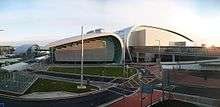
Terminal 2 is a 75,000 m2 (810,000 sq ft) terminal and pier (Pier E) which provides 19 air bridges for aircraft and is capable of handling 15 million passengers annually, thereby allowing the airport to handle 35 million passengers a year. The project was designed by Pascall+Watson architects and the total cost is put at €600 million. Another pier (Pier F) is planned to be built to the south of Terminal 2 when required. The majority of long-haul carriers have moved to Terminal 2,[24] including Aer Lingus, which has relocated all its mainline operations. Terminal 2 also features the US pre-clearance immigration facility which was previously housed in Terminal 1. Construction of Terminal 2 began on 1 October 2007, and it was officially opened on 19 November 2010 by the then Taoiseach Brian Cowen T.D. When the project was commissioned, it had seemed like a reasonable investment.[25] Mainline carriers such as Aer Lingus, American Airlines, Delta Air Lines, Emirates, Etihad Airways and United Airlines use Terminal 2.[26]
Safety and security
DAA has its own branch of the Airport Police Service which is mandated to provide aviation and general policing at the airport. The Airport Police Station is centrally located on the Arrivals road between Terminals 1 and 2. The airport also has its own Airport Fire and Rescue Service which provides cover to the entire campus, its roadways and lands.
The Office of the Revenue Commissioners provide a customs service to both passenger and cargo terminals, while the Department of Agriculture also has a presence in the airport. Garda Síochána (GNIB) provides an Immigration service for all international passengers arriving at the airport. The Gardaí also have a small sub-station located beside the old terminal.
In 2016 it was confirmed that armed Garda Regional Support Units (RSU) would be deployed overtly to patrol Dublin Airport and Dublin Port full-time on foot inside terminal buildings and via vehicles outside and surrounding the perimeter to counter the rising threat of terrorist attacks in Europe.[27] The decision was made as a direct result of the 2016 Brussels bombings in Belgium.[28]
Maintenance facilities
Aer Lingus, Ryanair, CityJet, Eirtech and Dublin Aerospace have aircraft maintenance hangars and facilities at Dublin Airport. In 2010 Etihad Airways announced a new maintenance hangar which will handle the Airbus A330-200 which the airline uses on their route from Abu Dhabi to Dublin. In time the airline will allow other airlines to use this facility.[29]
Airport developments
New air traffic control complex
Planning is currently under way for a new air traffic control complex and control tower which will replace the existing structure. The new facility has been designed by Scott Tallon Walker architects. A planning application was submitted in August 2009.[30] The new control tower will be 86.9 m (285 ft) in height. The new control tower is necessary because the construction of the future parallel runway will obstruct visibility of certain parts of the airport from the existing control tower.[31]
New runway
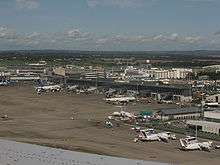
A new runway measuring 3,110 m (10,203 ft) is planned to be built parallel to the existing runway 10/28, which opened in 1989.[32] Planning permission for the runway was granted in August 2007, with 31 planning conditions attached.[33]
The new runway will replace runway 11/29 (which is no longer in use as a runway and is now used for aircraft parking) and will be built 1,690 m (5,545 ft) to the north of and parallel to the existing runway 10/28. The new runway will allow the airport to accommodate 30 million passengers per annum once in operation, and it will be 3,110 m (10,203 ft) long.[34] In March 2009 the DAA announced in a proposal for consultation that the new runway may be built to a length of 3,660 m (12,008 ft) following consultation with potential long-haul carriers. A runway of this length would allow direct flights from Dublin to the Far East.[35] The runway was expected to cost in the region of €300 million.
In the meantime, the company has invested heavily in extending aprons and creating rapid exit taxiways to derive maximum efficiency from the existing main runway. Runway 11/29, the shortest and one of the oldest runways, is closed to allow overspill aircraft parking. This runway will disappear under the new parallel runway in due course.
After a delay of several years due to the global financial crisis and predictions of falling consumer demand, it was announced in April 2016 that the new runway would start construction in 2017 and to be completed by 2020.[36][37]
Airlines and destinations
Passenger
^1 Ethiopian Airlines has a fuel stop on its flights from Addis Ababa to Toronto-Pearson and Washington-Dulles via Dublin on outbound flights only, due to weight restrictions on departure from ADD. The airline has no rights to transport passengers solely between DUB and IAD or YYZ and thus does not carry passengers from Dublin on these flights.
Cargo
| Airlines | Destinations |
|---|---|
| Air France Cargo | Chicago-O'Hare, Paris-Charles de Gaulle |
| ASL Airlines Belgium operated by Bluebird Cargo | Liège |
| Bluebird Cargo | Reykjavík-Keflavik |
| DHL Aviation operated by EAT Leipzig | East Midlands, London-Luton |
| FedEx Express | Paris-Charles de Gaulle, London-Stansted |
| UPS Airlines operated by Star Air (Maersk) | Cologne/Bonn, Shannon |
| West Atlantic | Coventry |
| Woodgate Aviation | East Midlands, Isle of Man |
Statistics
Passenger numbers
Passenger numbers at Dublin Airport increased every year during the 10 years between 1998 and 2008, by an average of 10.2% per annum from around 11.6 million to over 23.4 million. Passenger numbers fell however during the subsequent two years to around 18.4 million in 2010, with a small increase to 18.7 million in 2011[55] and 19.1 million in 2012,[56] then 2013 saw a significant increase of 5.6% to 20.2 million.[57] In 2014, passenger numbers increased by almost 8% to over 21.7 million.[58] Traffic growth of over 15% during 2015 resulted in passenger numbers exceeding 25 million for the first time. The previous record of 23.46 million (set in 2008) was exceeded during the first week of December 2015.[59]
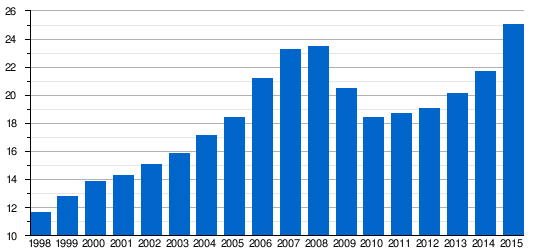 |
| Updated: 20 January 2016. |
| Year | Passengers | Passengers Change YoY % |
|---|---|---|
| 1998 | 11,641,100 | – |
| 1999 | 12,802,031 | |
| 2000 | 13,843,528 | |
| 2001 | 14,333,555 | |
| 2002 | 15,084,667 | |
| 2003 | 15,856,084 | |
| 2004 | 17,138,373 | |
| 2005 | 18,450,439 | |
| 2006 | 21,196,382 | |
| 2007 | 23,287,438 | |
| 2008 | 23,466,711 | |
| 2009 | 20,503,677 | |
| 2010 | 18,431,064 | |
| 2011 | 18,740,593 | |
| 2012 | 19,099,649 | |
| 2013 | 20,166,783 | |
| 2014 | 21,712,173 | |
| 2015 | 25,049,335 | |
| Sources: 1998–2001 – Aer Rianta[60] 2002–2005 – DAA[61] 2006–2012 – DAA[56] 2013–2015 – DAA[57] | ||
Busiest routes
As can be seen from the list below, the top three routes from Dublin are all to London airports. As of 2014 the Dublin–London route is one of the worlds busiest international air routes, with 640 weekly flights between the two cities.
| Rank | Airport | Passengers Handled | % Change 2014/15 | |
|---|---|---|---|---|
| 1 | London Heathrow | 1,683,041 | | |
| 2 | London Gatwick | 1,086,940 | | |
| 3 | London Stansted | 879,552 | | |
| 4 | Manchester | 862,928 | | |
| 5 | Birmingham | 785,376 | | |
| 6 | Paris Charles de Gaulle | 702,945 | | |
| 7 | New York JFK | 626,508 | | |
| 8 | Amsterdam | 611,600 | | |
| 9 | Edinburgh | 540,495 | | |
| 10 | Frankfurt | 514,932 | | |
| 11 | Madrid | 472,168 | | |
| 12 | Barcelona | 468,464 | | |
| 13 | Málaga | 465,597 | | |
| 14 | London City | 452,941 | | |
| 15 | Brussels | 449,489 | | |
| 16 | Glasgow International | 449,341 | | |
| 17 | Faro | 410,486 | | |
| 18 | Dubai | 401,541 | | |
| 19 | Bristol | 378,077 | | |
| 20 | London Luton | 340,713 | | |
| 21 | Chicago O'Hare | 339,707 | | |
| 22 | Liverpool | 338,495 | | |
| 23 | Boston | 332,569 | | |
| 24 | Abu Dhabi | 315,471 | | |
| 25 | Copenhagen | 315,057 | | |
| Source: Central Statistics Office[62] | ||||
Ground transport

Dublin Airport is located just off the M1 and the M50 10 km (6.2 mi)[2] north from the city centre and 2 km (1.2 mi) south of the town of Swords. The airport is approximately 210 kilometres (130 mi) away from both Limerick and Galway and 266 kilometres (165 mi) from Cork. Belfast is around 158 kilometres (98 mi) away. Until the Metro North rail link to Dublin city centre is completed (see below), the public transport options to the city are taxis, buses and private transport. Passengers can however connect by bus or taxi to Dublin's railway stations.
Bus services
Dublin Airport is served by a large network of bus and coach routes, serving both the wider Dublin area and intercity links to the rest of Ireland.[63] More than 700 buses a day service Dublin Airport. In Dublin city, Dublin Bus is the main provider of transport to and from the airport operating Airlink Express route 747 to the city centre terminus of Busáras and the railway stations of Dublin Connolly and Dublin Heuston.[64] In addition, Dublin Bus runs local stopping services that serve such residential areas as Santry, Swords, Rathfarnham, Sutton, Malahide, Beaumont, Harold's Cross, Drumcondra and Portmarnock.
Aircoach offers a number of coach services from the Airport to the Dublin area, serving both the city centre and surrounding areas including Donnybrook, Leopardstown, Sandyford, Dalkey, Greystones. Bray, Blackrock, Dún Laoghaire Killiney and Sandymount.[65]
At a national level, Bus Éireann offers a large number of routes from Dublin Airport to 18 destinations such as Galway, Wexford, Sligo, Donegal, Drogheda, Navan, Cork, Wicklow and Letterkenny.[66] Bus Éireann and Ulsterbus Goldline jointly offer cross-border bus services, namely X1/X2 to Belfast and 274/X33/X4 to Derry.
Citylink and Gobus offer services to Galway while Éirebus and JJ Kavanagh operate regular services to Limerick, Kilkenny and Waterford. Wexfordbus connects the airport with Wexford.
Taxi
Taxis are available at Taxi Ranks located directly outside of Terminal 1 and Terminal 2. Should passengers require any further assistance, a taxi dispatcher is available at both taxi ranks.[67]
Rail
Iarnród Éireann (Irish Rail) provide suburban and intercity railway services from Dublin Connolly and Dublin Heuston railway stations. There are direct regular bus services to both stations from the airport. Some city bus services serve Drumcondra suburban railway station, which is on the Connolly to Maynooth railway line while the 102 route connects Dublin Airport to Sutton DART station. Bus services to Busáras/Dublin Connolly and Dublin Heuston railway stations connect with the Luas Red Line.
Plans for rail link
For many years, it was expected that Iarnród Éireann, the state railway company, would extend the Dublin Area Rapid Transit (DART) with a spur off the Dublin to Belfast line that would serve the airport and Swords. These plans were replaced with plans for an underground metro line, which would run from the city centre to Swords via the airport. The route for the line, Metro North, was announced on 19 October 2006 and was designed to connect with several other modes of transport. On 12 August 2011, it was announced that the Metro North plan would be deferred indefinitely due to a lack of resources to fund the project.[68]
In September 2015, after several years of delays due to funding constraints in light of the economic crisis, it was announced that Metro North would finally proceed. The line would begin underground at St Stephen's Green, where an interchange would be possible with the Luas Green Line, providing a fast link to the airport from many suburbs in South Dublin. In the future, once the DART Underground project is constructed, a DART station will be built at St Stephen's Green, allowing seamless interchange from Metro North to the DART and Irish Rail network.
The second key station in the city centre will be on O'Connell Street, where the metro will interchange with the Luas Green Line. Metro North continues underground through Drumcondra, where another interchange with the Irish Rail network will be possible.
After resurfacing in the Glasnevin area, the line passes through Ballymun and Dardistown, and goes back underground just before the airport where a station will be located, and then resurfaces north of the airport and continues onwards to Swords.
The journey time from the City Centre to the airport will be 19 minutes.
Construction will begin in 2021, with the line scheduled to open in 2026 or 2027.
Dublin Airport City
In 2008, The Dublin Airport Authority announced plans for an ambitious development of the Dublin Airport area and surrounding environs.[69] This ambitious project might develop a 350-acre (1.4 km2) land reserve situated to the east of Dublin Airport and might cost in the region of €4 billion. Of this 350 acres (1.4 km2), 90% is already owned by the Dublin Airport Authority, and they are confident that they will be able to purchase the remaining pockets. The development might be mainly high rise and could be completed by 2028. There may be 600,000 m2 (6,500,000 sq ft) of office space along with 40,000 m2 (430,000 sq ft) of retail, hotel and conference facilities. It is expected that the journey time from office to airport will be in the region of 6 minutes.
See also
References
- 1 2 3 Ó Conghaile, Pól (19 January 2015). "Dublin Airport: Memories take flight as Ireland's gateway celebrates 75 years". Irish Independent. Retrieved 18 January 2016.
- 1 2 3 EIDW – Dublin/International (PDF). AIP and charts from the Irish Aviation Authority.
- ↑ "Dublin Airport Sets New Record With 25M Passengers in 2015". Daa.ie. 2016-01-18. Retrieved 2016-01-20.
- ↑ "Monthly Review – Irish Aviation Authority". Iaa.ie. Retrieved 2016-01-18.
- ↑ "daa – Home". Retrieved 2 June 2015.
- ↑ "Latest News".
- ↑ "Air Operator Certificate Holders".
- ↑ "1937 – Dublin Airport – Architecture of Fingal – Archiseek.com". Archiseek.com. Retrieved 2 June 2015.
- ↑ https://www.dublinairport.com/about-us/did-you-know/history
- ↑ https://www.dublinairport.com/about-us/did-you-know/history
- ↑ https://www.dublinairport.com/about-us/did-you-know/history
- ↑ https://www.dublinairport.com/about-us/did-you-know/history
- ↑ "Latest News".
- 1 2 "Dublin AIrport Information". CARHIRE.ie. Retrieved 8 April 2015.
- ↑ New 'open skies' deal to see end of Shannon stopovers, The Irish Times, 6 June 2003
- ↑ Mulligan, John (3 June 2015). "Irish airports lose exclusivity on offering US pre-clearance". Irish Independent. Retrieved 30 March 2016.
- ↑ "Dublin Airport Guide.com – Dublin Airport Authority Renamed". Retrieved 2 June 2015.
- ↑ "Press Releases > Name Change Takes Effect At daa". Retrieved 2 June 2015.
- 1 2 https://issuu.com/daapublishing/docs/daa_annual_report_2015?e=5056106/38974820
- ↑ https://www.dublinairport.com/latest-news/detail/dublin-airport-grows-ni-resident-business-by-37-in-2015
- ↑ "Pier D To Open on Sunday". Build.ie, Ireland's Construction Directory. 26 October 2007.
- ↑ "Dublin Airport – Pier D Environmental Graphics". SOM.com.
- ↑ "Site Error". Retrieved 2 June 2015.
- ↑ "New Terminal to Transform Dublin Airport". Dublinairportt2.com. Retrieved 4 April 2014.
- ↑ "Frankfurt Business Media". Retrieved 2 June 2015.
- ↑ "Airlines Flying From Dublin Airport T2". Dublin Airport T2. Retrieved 20 July 2011.
- ↑ Lally, Conor (23 March 2016). "Gardaí to begin armed policing at Dublin Airport". The Irish Times. Retrieved 24 March 2016.
- ↑ "Armed Gardaí to patrol Dublin Airport in response to Brussels attacks". Newstalk. 24 March 2016. Retrieved 24 March 2016.
- ↑ Hancock, Ciarán. "One more thing." Irish Times. Friday 18 June 2010. Retrieved on 13 July 2010.
- ↑ "iaadublincontroltower.ie".
- ↑ Neil Callanan (13 July 2008). "New control tower needed at Dublin airport as it 'can not see end of new runway'". Tribune.ie. Retrieved 3 February 2011.
- ↑ "You have to be pretty thick to land a Jumbo.". The Irish Independent. 21 June 1989. Retrieved 15 December 2013.
- ↑ Dublin airport to get new runway, The Irish Times, 13 April 2006
- ↑ "Parallel Runway". Dublinairport.com. Retrieved 3 February 2011.
- ↑ "DAA PROPOSED CAPITAL INVESTMENT PROGRAMME 2010 – 2014". Aviationreg.ie. Retrieved 3 February 2011.
- ↑ John Mulligan (2016-04-07). "Dublin Airport to get new €320m runway, supporting 1,200 jobs during construction". Irish Independent. Retrieved 2016-04-07.
- ↑ Dublin Airport Authority (2016-04-07). "DAA To Build New Runway At Dublin Airport". Retrieved 2016-04-07.
- 1 2 3 "Aer Lingus announces new routes to Miami, Porto and Split". RTÉ News. Retrieved 15 November 2016.
- 1 2 3 "Aer Lingus Cargo Winter 2016 -2017 effective October 30" (PDF). Aer Lingus Cargo. Retrieved 27 October 2016.
- ↑ "Aer Lingus to close Liverpool to Dublin route". Liverpool Echo. Retrieved 30 October 2016.
- ↑ "Falcon Holidays". Falcon Holidays. 24 November 2016.
- ↑ "Flight Timetable - Falcon".
- ↑ "Crystal Summer Ireland Holidays - Lakeside Holidays Across Europe".
- 1 2 3 4 5 6 7 8 "Sunway-Flights". Sunway. 19 October 2016.
- ↑ "Topflight-Flights to Sorrento (Naples)". Topflight. 24 May 2015.
- ↑ "EI-STA – Aircraft info and flight history". Flightradar24 AB. Retrieved 9 October 2015.
- ↑ "FreezePage". Retrieved 2 June 2015.
- 1 2 "Crystal Ski Holidays". Crystal Ski Ireland. Retrieved 7 November 2015.
- ↑ "Delta announces new routes to connect New York-JFK, Boston to Europe". Delta Air Lines Inc. Retrieved 28 September 2016.
- 1 2 "Press Office :: Scotland's Airline spreads its wings - Loganair".
- ↑ "FlyOne – Winter Schedule".
- ↑ "FI1509 flight history". Flightradar24 AB. Retrieved 9 October 2015.
- 1 2 "Direct Flights From Dublin Airport To Mexico And Jamaica In 2016".
- ↑ "Transavia adds new routes from Munich in S17". routesonline. Retrieved 29 September 2016.
- ↑ "DAA 2011 Annual Report". Retrieved 2 June 2015.
- 1 2 "Dublin Airport Authority Annual Report 2012". DAA. 2012. p. 97.
- 1 2 "Press Releases > Dublin Airport Passengers Up 6% to 20.2M In 2013". Daa.ie. 2014-01-13. Retrieved 2014-02-16.
- ↑ "Dublin Airport Passenger Numbers Up 8% to 21.7M". Daa.ie. 2015-01-12. Retrieved 2016-01-20.
- ↑ "Dublin Airport Breaks Annual Passengers Numbers Record". Daa.ie. 2014-12-04. Retrieved 2016-01-20.
- ↑ Aer Rianta Regional Analysis of Passenger Movements
- ↑ Dublin Airport Authority plc Annual Report and Accounts 2005
- ↑ "Passenger Movement by Irish Airport, Direction, Foreign Airport and Month". CSO. December 2015. Retrieved 17 March 2016.
- ↑ "Coach and Airport Bus Services To and From Dublin Airport".
- ↑ "Airport Services - Dublin Bus".
- ↑ "Fares - Aircoach".
- ↑ "Dublin Airport - Bus Éireann - View Ireland Bus and Coach Timetables & Buy Tickets".
- ↑ "By Rail". DAA. Retrieved 19 January 2016.
- ↑ Ireland drops €5.6 billion metro projects, December 2011
- ↑ "DAA Announces Plans for World Class €4 Billion Development - Dublin Airport City". Dublin Airport Authority. 2008-04-25. Retrieved 2016-03-25.
External links
| Wikimedia Commons has media related to Dublin Airport. |
- Official website
- Dublin Airport Authority
- Current weather for EIDW at NOAA/NWS
- Accident history for DUB at Aviation Safety Network
- Latest ops reports for EIDW from Aireport
